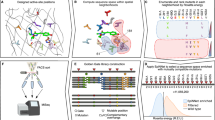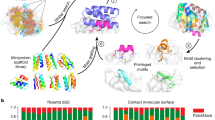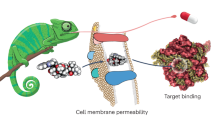Abstract
The ligand interaction scan (LIScan) method is a general procedure for engineering small molecule ligand–regulated forms of a protein that is complementary to other 'reverse' genetic and chemical-genetic methods for drug-target validation. It involves insertional mutagenesis by a chemical-genetic 'switch', comprising a genetically encoded peptide module that binds with high affinity to a small-molecule ligand. We demonstrated the method with TEM-1 β-lactamase, using a tetracysteine hexapeptide insert and a biarsenical fluorescein ligand (FlAsH).
This is a preview of subscription content, access via your institution
Access options
Subscribe to this journal
Receive 12 print issues and online access
$259.00 per year
only $21.58 per issue
Buy this article
- Purchase on Springer Link
- Instant access to full article PDF
Prices may be subject to local taxes which are calculated during checkout



Similar content being viewed by others
References
International Human Genome Sequencing Consortium. Nature 431, 931–945 (2004).
Alaimo, P.J., Shogren-Knaak, M.A. & Shokat, K.M. Curr. Opin. Chem. Biol. 5, 360–367 (2001).
Bishop, A.C. et al. Nature 407, 395–401 (2000).
Stankunas, K. et al. Mol. Cell 12, 1615–1624 (2003).
Buskirk, A.R., Ong, Y.C., Gartner, Z.J. & Liu, D.R. Proc. Natl. Acad. Sci. USA 101, 10505–10510 (2004).
Hahn, M.E. & Muir, T.W. Trends Biochem. Sci. 30, 26–34 (2005).
Griffin, B.A., Adams, S.R. & Tsien, R.Y. Science 281, 269–272 (1998).
Adams, S.R. et al. J. Am. Chem. Soc. 124, 6063–6076 (2002).
Hallet, B., Sherratt, D.J. & Hayes, F. Nucleic Acids Res. 25, 1866–1867 (1997).
Matagne, A., Lamotte-Brasseur, J. & Frere, J.M. Biochem. J. 330, 581–598 (1998).
Acknowledgements
We thank all members of our group for help and support. We also thank M. Marmor, D. Reichmann, Y. Shaul, E. Kario and D. Chuderland for help with methods; G. Schreiber, R. Seger, A. Navon, E. Bayer and S. Lev for advice and discussions. This work was supported by the J&R Center for Scientific Research, the Willner Center for Vascular Biology and La Fondation Raphael et Regina Levy. M.L. is the incumbent of the Harold L. Korda Professorial Chair in Biology.
Author information
Authors and Affiliations
Corresponding author
Ethics declarations
Competing interests
The authors declare no competing financial interests.
Supplementary information
Supplementary Fig. 1
Insertional mutagenesis of TEM-1 β-lactamase with the 4C motif. (PDF 6602 kb)
Supplementary Fig. 2
PCR and restriction analysis of 4C insertions in TEM-1 mutants. (PDF 310 kb)
Supplementary Fig. 3
Expression, purification and FlAsH binding of TEM-1 4C mutants. (PDF 79 kb)
Supplementary Fig. 4
Molecular models of FlAsH-sensitive TEM-1 mutant 4C-215. (PDF 1360 kb)
Supplementary Fig. 5
Possible modes of interaction of FlAsH with the CCPGCC peptide. (PDF 1252 kb)
Supplementary Table 1
Generation of TEM-1 4C-mutants and the primers used in inverse PCR insertional mutagenesis. (PDF 59 kb)
Rights and permissions
About this article
Cite this article
Erster, O., Eisenstein, M. & Liscovitch, M. Ligand interaction scan: a general method for engineering ligand-sensitive protein alleles. Nat Methods 4, 393–395 (2007). https://doi.org/10.1038/nmeth1046
Received:
Accepted:
Published:
Issue Date:
DOI: https://doi.org/10.1038/nmeth1046
This article is cited by
-
Palladium-triggered deprotection chemistry for protein activation in living cells
Nature Chemistry (2014)
-
Brought to life: targeted activation of enzyme function with small molecules
Journal of Chemical Biology (2009)



